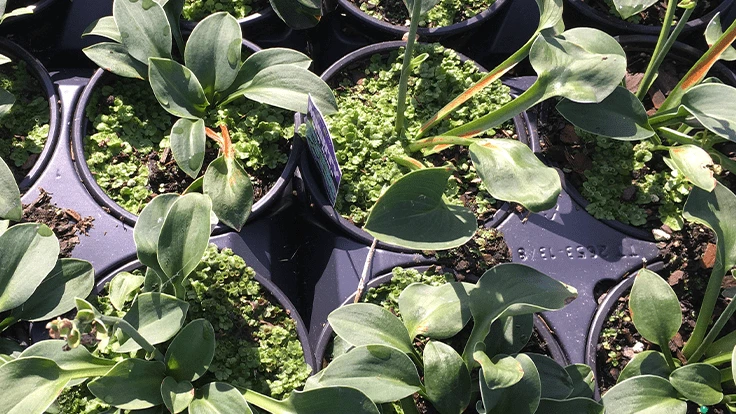

Liverwort
Liverwort is primarily a problem in herbaceous perennials, woody ornamentals or crops with long production cycles with a dormant or vernalization period where crops remain damp for long periods of time. There are thousands of liverwort species with Marchantia polymorpha being the most common one prevailing in greenhouses and nurseries, according to Marble et al., 2017.
Liverwort, including M. polymorpha, prefer cool temperatures, low ultraviolet (UV) light radiation, high fertility and moist or damp substrate. It reproduces rapidly in the presence of overhead irrigation, poorly drained or moist areas. The optimum temperature for vegetative growth is 64-72 °F. These environmental conditions are common inside greenhouses and nurseries, and the organism thrives and spreads rapidly once established in containers.
Liverworts form dense, prostrate mats covering the soil or container media surface. In container production, liverwort becomes highly competitive with the ornamental crop for water, nutrients and space. The liverwort mat can prevent the irrigation water and fertigation from reaching the root zone of the ornamental crop and can repel water when dry. As a result, the overall quality and market value of the ornamental crop decreases.
M. polymorpha is a non-vascular plant and has a thallus structure. It can reproduce through both asexual as well as sexual reproductive cycles. In gametophytic life cycle, the liverwort propagates asexually by producing gemmae within the gemma cups. Each gemma cup can produce numerous gemmae (asexual plant buds). Gemmae are released to the immediate area when splashed by water from rain or irrigation. After leaving the mother plant, each gemma can form one to two clonal plants after contact with moist soil or substrate.
At temperatures of 50-59 °F, M. polymorpha develops sexual structures. Stalked, umbrella-like male and female reproductive structures are borne on separate thalli. Sperm cells produced by the antheridia travel via water (rainwater or irrigation splashing on the upper surface of the antheridiophore) to fertilize the eggs on the undersides of the archegoniophore, according to Marble et al., 2017. After fertilization, spore development takes place. Once they mature, they get dispersed by wind or water and germinate on moist substrate under suitable growing conditions.
Managing liverwort in container production can be challenging. For a successful liverwort control, it may require a combination of herbicide applications along with proper cultural and sanitation practices. There are very few herbicides labeled for greenhouses, as there can be phytotoxic effects on the ornamentals.
For more information on pre- and postemergence herbicides that have shown some degree of liverwort control and are safe to apply to ornamental plants in nurseries or greenhouses, visit www.canr.msu.edu/resources/identifying-and-managing-liverwort-in-michigan-nurseries-and-greenhouses

Explore the August 2020 Issue
Check out more from this issue and find your next story to read.
Latest from Nursery Management
- John Ruter shares UGA's latest woody and herbaceous ornamental plant breeding projects
- Conor Foy joins EHR's national sales team
- Pantone announces its 2026 Color of the Year
- Syngenta granted federal registration for Trefinti nematicide/fungicide in ornamental market
- Get to know Kayela Aeppli
- HILA 2025 video highlights: John Gaydos of Proven Winners
- Q&A with Justin Bartlett
- Be the best choice





